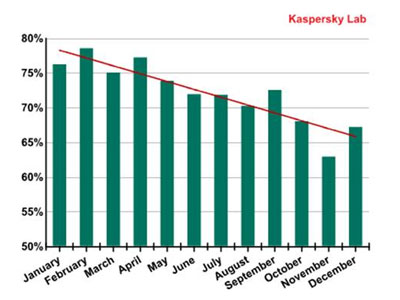
Top stories


Marketing & MediaCammy Msimango on finding her footing in South Africa’s fast-moving digital newsroom
Esther Tomorrow, MDNTV 22 hours




More news




The main reason behind the decrease in spam volume is the overall heightened level of anti-spam protection. Spam filters are now in place on just about every email system, even free ones. Also, many email providers have introduced mandatory DKIM signature policies (digital signatures that verify the domain from which emails are sent). Another factor behind the falling levels of spam is inexpensive advertising on legal platforms. With the emergence of Web 2.0, advertising opportunities on the Internet have skyrocketed - banners, context-based advertising, and ads on social networks and blogs.
In spite of the drop in the overall percentage of spam in mail traffic, the proportion of emails with malicious attachments fell only slightly to 3.4%. This is a very large percentage, considering that this number reflects only emails with malicious attachments and ignores other spam emails containing links to malicious websites. Meanwhile, the range of different subjects used in malicious emails was impressive in 2012. Previously malicious users relied on fake notifications from hosting services, social networks, delivery services, and messages from financial and government organisations. In 2012, they expanded their repertoire to include fake messages from a variety of airlines, hotel reservation services, and coupon services.

2012 saw some major changes among the countries from which spam originates. China, which was not even in the top 20 sources of spam in 2011, took first place in 2012, accounting for 19.5% of all unsolicited mail. Spam originating in the US increased 13.5 percentage points, to 15.6% - enough to take second place. Asia remains the leading region for spam distribution. Over the year, the region's share of the world's junk mail rose 11.2 percentage points to clear 50%. Due to the increased spam contribution from the US, North America took second place in the top 10 with 15.8% - up from just 2% in 2011. At the same time, the amount of spam originating in Latin America fell by 8 percentage points and closed at 11.8%. Europe also dropped down the ranks. In 2012, the total amount of spam originating in Western and Eastern Europe combined came to 15.1%, which is about half the amount recorded in 2011.
The largest number of email antivirus detections in 2012 was recorded in the US. Germany led for several months over the year, however ended up in second place at the close of the year. Third place went to the UK. Russia, which was the number one target in 2011, fell to ninth place in 2012.
"In 2012, the percentage of spam decreased over the course of the year, and during the final three months of 2012 the figure remained below 70%. This drop is the result of a gradual departure of advertisers from spam to other, more convenient and legal means of promoting goods and services. However, that doesn't mean spam is headed the way of the dodo anytime soon: malicious spam, fraud, and advertising of illegal goods cannot simply or easily migrate to legal platforms, due to their own inherently criminal nature. We expect that the decline in spam volumes in 2013 will be negligible at best," Darya Gudkova, head of content analysis & research, Kaspersky Lab.